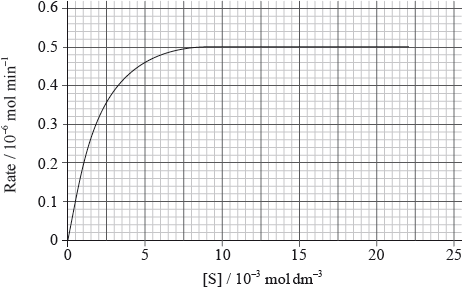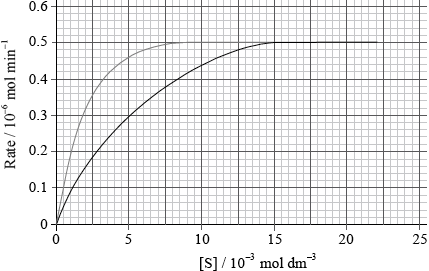| Date | November 2009 | Marks available | 5 | Reference code | 09N.3.hl.TZ0.B2 |
| Level | HL | Paper | 3 | Time zone | TZ0 |
| Command term | State and explain | Question number | B2 | Adapted from | N/A |
Question
Enzymes are proteins which play an important role in the biochemical processes occurring in the body.
The graph below shows how the rate of an enzyme-catalysed reaction changes as the substrate concentration is increased.
State the major function of enzymes in the human body.
Describe the mechanism of enzyme action in terms of structure.
Use the graph to determine \({V_{\max }}\) and the Michaelis constant, \({K_{\text{m}}}\).

\({V_{\max }}\):
\({K_{\text{m}}}\):
Draw a line on the graph to represent the effect of adding a competitive inhibitor.
State and explain the effects of heavy-metal ions and temperature increases on enzyme activity.
Markscheme
catalyse/speed up chemical reactions (in the body) / catalyst;
binding on the active site / lock and key / formation of substrate enzyme complex;
Do not allow bind to enzyme.
\({V_{\max }} = 0.5{\text{ (}} \times {\text{1}}{{\text{0}}^{ - 6}}{\text{ mol}}\,{\text{mi}}{{\text{n}}^{ - 1}}{\text{)}}\);
\({K_{\text{m}}} = \left( {{\text{[S] when }}v = \frac{1}{2}{V_{\max }} = } \right){\text{ 1.5 (}} \times {\text{1}}{{\text{0}}^{ - 3}}{\text{ mol}}\,{\text{d}}{{\text{m}}^{ - 3}}{\text{)}}\);
Accept any value between 1.2 and 1.5.
line on graph showing reduced gradient but same final \({{V_{\max }}}\);

Heavy-metal ions:
react (irreversibly) with –SH group / replaces hydrogen atom with heavy-metal atom/ion;
Accept heavy metal binding to active site.
Accept poisons enzymes.
decrease activity/rate;
Temperature changes:
increase in temperature increases (initial) activity/rate;
more reactants possess (minimum) activation energy;
at high temperature enzymes become less effective / above 40 °C activity/rate decreases / denatured / OWTTE;
for both (heavy-metal ions and temperature changes) (tertiary) structure disrupted / change of shape means active site stop working / OWTTE;
Examiners report
The major function of enzymes in the human body was very well answered.
Most candidates were able to describe the mechanism of enzyme action in terms of structure.
In addition, the idea of a competitive inhibitor, \({V_{\text{m}}}\) and \({K_{\text{m}}}\) were all clearly understood and many candidates scored full marks in (c) (i) and (ii).
In addition, the idea of a competitive inhibitor, \({V_{\text{m}}}\) and \({K_{\text{m}}}\) were all clearly understood and many candidates scored full marks in (c) (i) and (ii).
In (d) the answers tended to vary and many candidates did not distinguish between the temperature effect below and above 40 °C.

